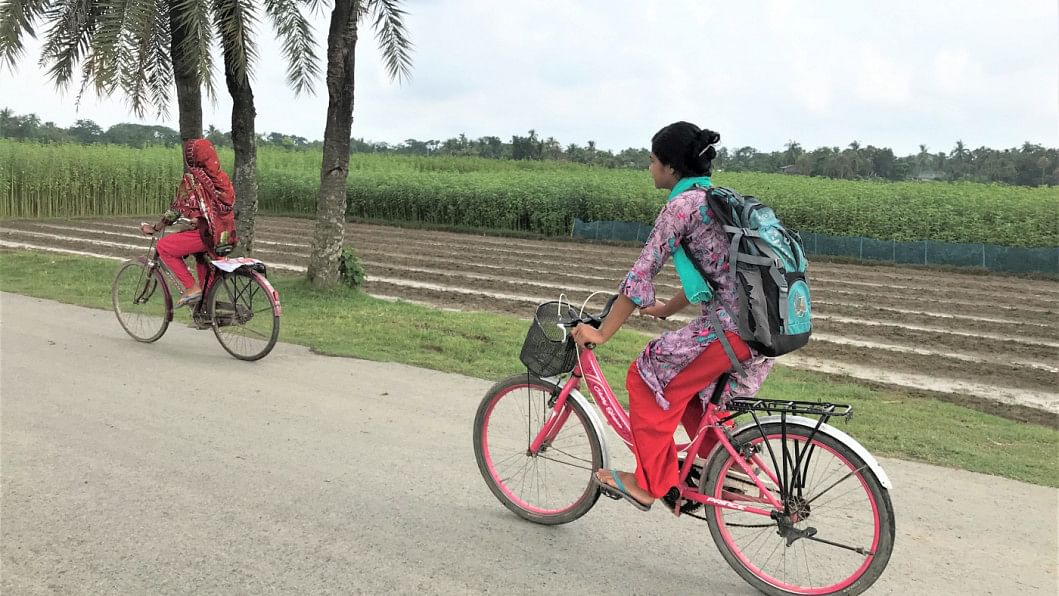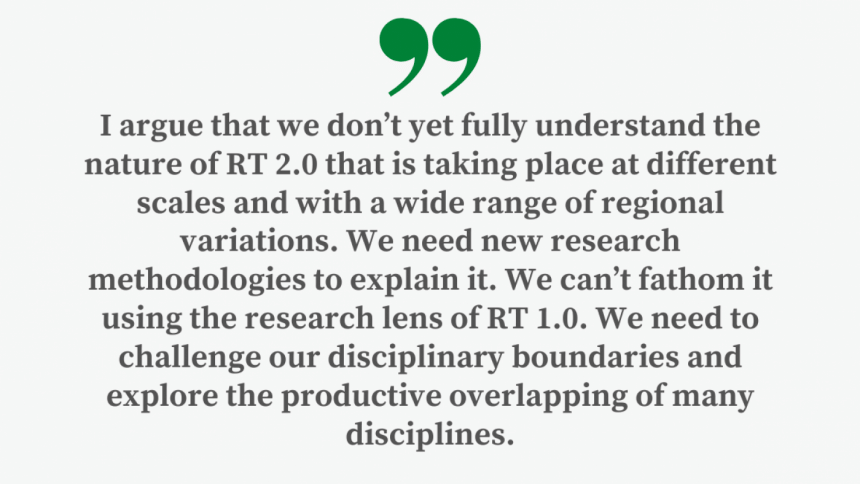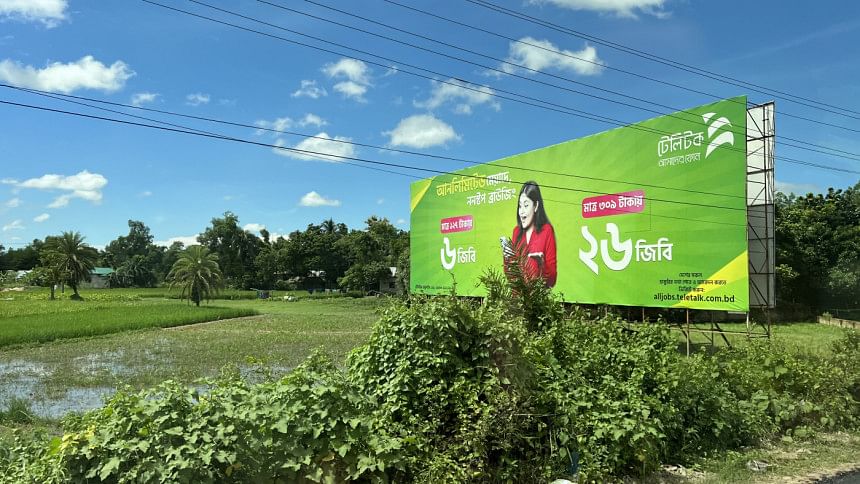Researching Rural Transformation 2.0 in Bangladesh

A lot has been going on in rural Bangladesh. In an earlier column, I called it Rural Transformation (RT) 2.0 during the decades 2000-2020 (RT 1.0 took place in the first three decades after independence).
Do we fully understand RT 2.0? I would like to argue that we need new research methodologies to understand the complex nature of the rural change in the last two decades.
Allow me to share some of my recent experience of road trips through sections of rural Bangladesh.
The futility of old binaries
In Shibrampur village of Magura, a farmer named Showkat explained to me the process of cultivating dragon fruit, an exotic crop with origins in Central America and which was first introduced to Bangladeshi soil sometime around 2013-14. The fruit grows on a climbing cactus that sprouts roots as it creeps its way up a prefabricated concrete post, and spreads its green mane through the circular support of a recycled tyre.
Thanks to its taste and purported health benefits, dragon fruit has been a global hit. In 2020, Thailand, the world's top dragon fruit exporter, earned USD 1.2 billion from exporting it. Vietnam was not far behind.
In the same year, Bangladeshi farmers grew 8,660 tonnes of the fruit – more than double the total yield of the previous year. Jhenaidah is considered the hub of its commercial cultivation, accounting for 39 percent of Bangladesh's total production. Among other districts, Jashore, Natore, and Bandarban have become major producers of dragon fruit. It's likely to become a key part of Bangladesh's global ambition. Its cultivation requires a concrete post, the product of a rural cottage industry. Then, it needs a recycled tyre, connecting the crop to both transportation and recycling industries.
How do we research the socioeconomics of dragon fruit cultivation to understand rural transformation in Bangladesh? It is not possible to classify dragon fruit cultivation simply as agricultural work. Traditional categories – for instance, the classification of farm and non-farm work – no longer seem tenable to explain the hybrid agro-industrial complex of a crop like dragon fruit.
Who is cultivating it? According to the Ministry of Agriculture, an overwhelming majority of dragon fruit growers are educated and young. Sometimes orders for the fruit are placed online or by mobile phone and delivered through a courier service. The complex ecology of the producer, the production method, and the crop's market distribution portrays a New Rural.
In short, the commercial cultivation of dragon fruit represents a new type of rural modernity that can't be explained by conventional research methodologies associated with RT 1.0.
We need new terminologies – beyond the binaries of farm and non-farm – to understand the complicated intersection of various market and social forces in the production of a non-native crop like dragon fruit.
The next-generation remittance influences
Consider the shifting roles of remittance in rural life. As I heard from groups of people in different villages in the Jashore-Kushtia-Jhenaidah region about their views on the remittance economy and its impact on them, it occurred to me that remittance research needs the next generation of critical inquiries.
People talked about how a "peer connection factor" inspires the youth of a village or a cluster of villages to try to go to the same destination abroad – be it Jeddah, Muscat, or Rome.
There is a village in Mirpur upazila of Kushtia where its youth went to Saudi Arabia en masse. Last June, I met a group of young men in a tiny medieval town called Albi in the south of France, almost all of whom came from one village in Sylhet and another in Shariatpur. What the youth in Albi told me about their future and their relationship with their motherland is structurally different from what I heard from migrants in the Middle East.
The crucial question here is: alongside remittance infusion into local economies, what value systems do our migrant workers bring home, and what are their influences on rural life in Bangladesh? What are the environmental implications of their business investments?
Much research has been done to understand the role of remittance on RT 1.0. Neoliberal economic policies and globalisation in the 1980s and 1990s created a vast global demand for skilled and unskilled labour from developing countries. Bangladeshi workers found new opportunities in the burgeoning labour market abroad, predominantly in the Middle East. And they began sending money back home.

Remittance was not as robust a factor during RT 1.0 as it has been during RT 2.0.
In 1980, Bangladesh's remittance earnings were USD 339 million. It crossed the USD 1 billion mark only in 1993. The GDP share of remittance was 1.87 percent in 1980, 2.58 percent in 1990, and 4.16 percent in 2000. It was during RT 2.0 that remittance became a key driver of the national economy. It crossed the USD 2 billion mark in 2001 and USD 10 billion in 2010. Remittance inflows crossed the USD 20 billion threshold in 2021. This is a new scale.
We need to pose a type of questions about remittance influences on the social fabric of rural Bangladesh, beyond indicators like poverty reduction, nutrition, education, and healthcare. What are the local effects of migrants' destination countries? What is the investment pattern from the Middle East remittance inflows relative to Europe? There is social mobility and citizenship availability for those who go to Europe, while there are very little of such opportunities for those who go to, say, Saudi Arabia. What are the ideological and entrepreneurial footprints of remittance in rural life?
Mobile technology in rural life
Mobile technology is a reality of RT 2.0. The milestones of the mobile phone market in Bangladesh support this assertion. Grameenphone, AKTEL, and Sheba were launched in 1997. One million mobile connections were reached in 2002. The state-owned Teletalk launched the country's first 3G network in 2012 and a 100 million connection target was reached the following year. In 2017, mobile subscriber penetration surpassed 50 percent of the population, followed by the introduction of 4G services the next year.
Today, it is nearly impossible to find a person in rural areas without a mobile phone.

How is mobile internet, particularly social media, changing the fabric of social and economic life in rural Bangladesh? How are Facebook (there are 44.7 million Facebook users in Bangladesh, 25 percent of the country's population, according to Statista; that's 23 percent for India) and TikTok transforming the imagination and self-image of the rural youth? According to a recent survey by the Brac Institute of Governance and Development (BIGD), 92 percent of rural households own a mobile phone and 33 percent use mobile-based internet daily.
I have seen rural entrepreneurs accessing information on poultry feed pricing via mobile internet. I have also seen some rural youth engaged in mobile-based gambling at tea stalls. Mobile phone-based citizen journalism has emerged as a major deterrent to violence against women and children. Mobile videos helped law enforcement agencies capture perpetrators of violence against minorities, while criminals have also used them to blackmail young schoolgirls.
Researchers need to go beyond singular narratives of economic growth and agricultural productivity and pay deeper attention to the contradictory nature of technological progress and its consequences for rural areas.
The rise of the rural middle class
A trip to a rural area in Bangladesh would convince anyone that there is a rising rural middle class – although by no means is it a uniform one across regions.
This is a consumer class like its urban counterpart with an appetite for, say, electronics (TV) and appliances (fridge), and a secret desire to flaunt wealth. The ostentatious single-family or apartment buildings, rising straight from the paddy field, demonstrate a new visual language with which the rural middle class announces its presence.
I visited a spacious rural convention centre that was hosting a wedding ceremony. The traditional rural idea of such a ceremony taking place under a shamiana in the courtyard of a rural homestead has been replaced by the urbanity of convention centres that are too common a site even in the deep rural. One of the ways to measure the economic muscle of the rural middle class is to understand the proliferation of an urban-style advertisement culture across rural areas. The boundary walls of private houses and markets feature brightly coloured advertisements for "smart" lungi, toothpaste, mobile phone, ceiling fan, noodles, television, wall paint, and water tanks, among other commodities.
But, as I observed, there is also a peculiar difference between the middle class of urban Bangladesh and that of rural Bangladesh.
The rural middle class is torn between an increasing consumerist mindset and an entrenched pastoral attachment to the land. On the one side, there is the gradual acceptance of middle-class values embedded in the ethos of individuality, social mobility, materialism, and transient work life. On the other side, there is a nativist veneration of the land as the source of livelihood and ancestral identity. As I spoke to several rural families, I realised how this powerful contradiction – the conflict of ephemerality and rootedness – shapes the self-image of the members of this rising class and affects how they do what they do.
In the context of Bengal's agrarian history and the long shadow of the Permanent Settlement, this dilemma is very different from that of the urban middle class that also has ties with the village land. Historian Ranajit Guha has explained this, "[The urban class's] world of culture was strictly circumscribed by the values of a middle class living off the fat of the land and divorced from the indigenous culture of its peasant masses."
My own father raised his family in the city with his professional job, but he also derived income from his inherited and acquired village land – a typical case of urban absentee landlordism.
But today's rising rural middle class is in and on the land. The land is both an asset and a burden. An asset, because it continues to provide a livelihood in one way or the other. A burden, because the children of the peasant see having anything to do with the land and agriculture as roadblocks to their middle class status. This is the flip side of what could be called a "personality revolution" in rural Bangladesh.
An acute shortage of agricultural labour across villages is a reality today, although mechanisation of agriculture, cropping intensity, and industrial farming increase total agricultural output.
I argue that we don't yet fully understand the nature of RT 2.0 that is taking place at different scales and with a wide range of regional variations. We need new research methodologies to explain it. We can't fathom it using the research lens of RT 1.0. We need to challenge our disciplinary boundaries and explore the productive overlapping of many disciplines.
Furthermore, we need a new generation of self-critical and multidisciplinary research agenda that challenges the lure of empirical certainty. Quantitative analysis has traditionally powered our positivistic research approach, that is, rational assertions being able to be verified with data and mathematical proof.
If we go beyond the economic determinism of development and entertain Amartya Sen's "development as freedom" argument, we can see that RT 2.0 is inherently multidirectional, contradictory, and non-teleological, meaning it is not steadily moving towards a single end or goal.
A farmer from a village named Katalmari in Kushtia told me that he valued his freedom to do work when he pleases more than being a "workaholic" on his agricultural land with a single-minded focus on material prosperity. I understood that he was talking about his freedom to choose and his pride in being who he wanted to be, instead of being a cog in the wheel of national progress. It is important to understand the mind of the New Peasant.
Let me end with a very personal experience.
Somewhere in Kushtia, while in the car on a rural road with my colleague, architect Faisal Kabir, I suddenly encountered a real-life drama. I hurriedly got out of the car. It was a captivating spectacle: Two early-20-something girls on bicycles, pedalling away – confident, focused, and undeterred. One donned a hijab, the other had her hair nicely clipped and was wearing a backpack. I asked my colleague and the driver where these girls might be going. Both told me that they were most likely NGO workers, reporting to their rural office.
I kept on watching them, spellbound, until they disappeared beyond the green horizon. I soon understood where they were really going. They were going to the future of Bangladesh.
Adnan Zillur Morshed, PhD, is an author and professor at the Catholic University of America in Washington, DC, and executive director at the Centre for Inclusive Architecture and Urbanism in Brac University.

 For all latest news, follow The Daily Star's Google News channel.
For all latest news, follow The Daily Star's Google News channel. 







Comments